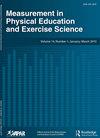美国儿童和青少年握力参照标准的设计与比较
IF 1.9
4区 教育学
Q2 EDUCATION & EDUCATIONAL RESEARCH
Measurement in Physical Education and Exercise Science
Pub Date : 2021-12-18
DOI:10.1080/1091367X.2021.2017292
引用次数: 2
摘要
我们根据65岁时的握力弱点,通过反向外推的切入点设计了青少年握力标准。基于骨矿物质含量不足(BMC)的现有标准也在全国代表性样本中进行了比较。共有6837名参与者(n = 2199≤18.9岁)参加了全国健康与营养检查调查,并对其优势手握力进行了评估。Lambda Mu Sigma回归用于创建强度百分位数,并确定与老年人临床相关虚弱(CRW)相关的阈值。大约93%和75%的年轻人分别符合基于CRW和BMC的标准。非西班牙裔白人和黑人青年更有可能达到握力临界值。与正常体重相比,体重不足的儿童更不可能达到力量标准(比值比为0.20至0.26),而超重/肥胖的青少年更有可能达到力量标准(比值比为1.38至2.71)。在评估握力时,这些标准可以与标准标准一起使用,或者代替标准标准。本文章由计算机程序翻译,如有差异,请以英文原文为准。
Design and Comparison of Criterion-referenced Standards for Grip Strength in U.S. Children and Adolescents
ABSTRACT We designed grip strength standards for youth by back-extrapolating cutpoints based on weakness at age 65. Existing standards, based on insufficient bone mineral content (BMC), were also compared in a nationally representative sample. Altogether, 6837 participants (n = 2199 ≤ 18.9 years of age) from the National Health and Nutrition Examination Survey had dominant hand, grip strength assessed. Lambda Mu Sigma regression was used to create percentiles of strength and identify thresholds linked with clinically relevant weakness (CRW) in older adults. Approximately 93% and 75% of young people met standards based on CRW and BMC, respectively. Non-Hispanic white and black youth were more likely to meet grip strength cutpoints. Underweight children were less likely (odds ratios = 0.20 to 0.26), while overweight/obese youth were more likely (1.38 to 2.71), to meet strength standards compared to normal weight. The standards can be used with, or in place of, normative standards when evaluating grip strength.
求助全文
通过发布文献求助,成功后即可免费获取论文全文。
去求助
来源期刊

Measurement in Physical Education and Exercise Science
Medicine-Orthopedics and Sports Medicine
CiteScore
4.20
自引率
33.30%
发文量
24
期刊介绍:
The scope of Measurement in Physical Education and Exercise Science (MPEES) covers original measurement research, special issues, and tutorials within six substantive disciplines of physical education and exercise science. Six of the seven sections of MPEES define the substantive disciplines within the purview of the original research to be published in the journal: Exercise Science, Physical Activity, Physical Education Pedagogy, Psychology, Research Methodology and Statistics, and Sport Management and Administration. The seventh section of MPEES, Tutorial and Teacher’s Toolbox, serves to provide an outlet for review and/or didactic manuscripts to be published in the journal. Special issues provide an avenue for a coherent set of manuscripts (e.g., four to five) to collectively focus in-depth on an important and timely measurement-related issue within the scope of MPEES. The primary aim of MPEES is to publish high-impact manuscripts, most of which will focus on original research, that fit within the scope of the journal.
 求助内容:
求助内容: 应助结果提醒方式:
应助结果提醒方式:


